Please note: In October 2020, we updated the DXOMARK Camera test protocol. Version 4 now includes image preview tests and a wide range of new test scenes as part of our new trustability evaluation, which measures the camera’s ability to deliver consistent still image and video quality across all shooting scenarios. We have retested this device using this new version of the test protocol and produced this completely updated review. For more information, please see our article about preview, trustability, and other version 4 updates of the DXOMARK Camera test protocol.
Vivo’s flagship X50 Pro+ pushes hard into high-end territory with specs that go toe-to-toe with phones at the top end of the market. Its Qualcomm Snapdragon 865 chipset outruns the 765G processor in the Vivo X50 Pro (an entirely different phone despite the similar label). It features 5G connectivity, a 6.56-inch AMOLED high-density screen, and configurations with 8 to 12 GB of RAM and 128 to 256 GB of UFS 3.1 storage.
The X50 Pro+ has a quad-camera setup like the older X50 Pro, but does not offer that phone’s remarkable gimbal-based stabilization. Its specs are nonetheless promising, featuring a 50 MP main camera with conventional OIS that bins down to 12.5 MP output. The longer of the two tele modules has some serious reach with a 124 mm-equivalent focal length. The mid-tele unit puts a 32 MP sensor (binned to 8 MP output) in front of a f/2.1 lens, again faster and higher-res than the X50 Pro. The wide camera has a 16 mm-equivalent field of view, with a resolution bump over the X50 Pro to 13 MP.
How does the new flagship from Vivo hold up against the competition? Find out in our updated review with new scores and analyses.
Key camera specifications:
- Primary: 50 MP 1/1.31-inch Quad-Bayer sensor, 24 mm-equivalent lens with f/1.9 aperture, dual-pixel PDAF and OIS
- Telephoto 1: 32 MP 1/2.8-inch sensor, 50 mm-equivalent (2x optical) lens with f/2.1 aperture, PDAF
- Telephoto 2: 13 MP 1/3.1-inch sensor, 124 mm-equivalent (5x optical) periscope lens with f/2.8 aperture, PDAF and OIS
- Ultra-wide: 13 MP 1/3.4-inch sensor, 16 mm-equivalent lens with f/2.2 aperture
- Dual-LED flash
- Video: 8K, 4K at 30 fps (tested)
- Qualcomm Snapdragon 865 chipset
About DXOMARK Camera tests: For scoring and analysis in our smartphone camera reviews, DXOMARK engineers capture and evaluate over 1600 test images and more than 2 hours of video both in controlled lab environments and in natural indoor and outdoor scenes, using the camera’s default settings. This article is designed to highlight the most important results of our testing. For more information about the DXOMARK Camera test protocol, click here. More details on how we score smartphone cameras are available here.
Please note that this device’s Camera protocol version 4 tests were carried out using a firmware version that will be made available to consumers via an OTA-update in March.
Update summary
Scoring
Sub-scores and attributes included in the calculations of the global score.
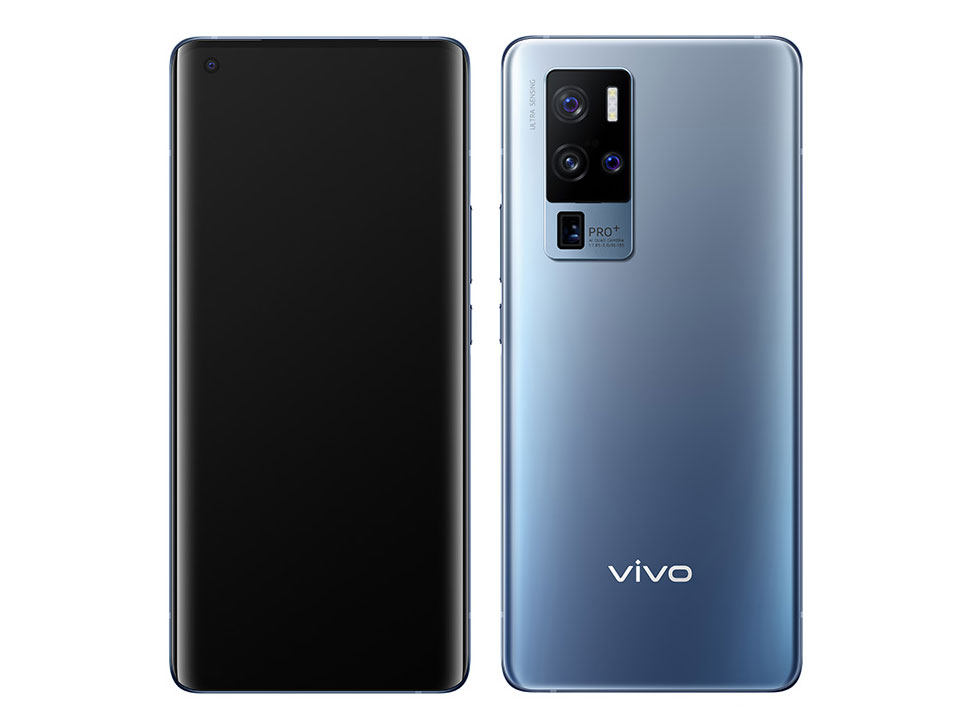
Vivo X50 Pro+


Use cases & Conditions
Use case scores indicate the product performance in specific situations. They are not included in the overall score calculations.
Outdoor
Photos & videos shot in bright light conditions (≥1000 lux)
Indoor
Photos & videos shot in good lighting conditions (≥100lux)
Lowlight
Photos & videos shot in low lighting conditions (<100 lux)
Friends & Family
Portrait and group photo & videos
The Vivo X50 Pro+ has increased its DXOMARK Camera score by 4 points under our latest round of testing. Now at an impressive 131, the X50 Pro+ ranks up there among the top smartphones we’ve tested.
The X50 Pro+ posts a new Photo sub score of 137. Although that’s down 2 points compared to our previous test, this is in large part due to the Vivo’s excellent results for tele-lens shots being moved over into the new Zoom sub score.
Dynamic range is extended in most scenes and target exposure is accurate in indoor and low-light shots. Noticeably low target exposures in backlit scenes is a drawback, though, and ghosting artifacts are often visible in HDR shots. Color is good, with accurate white balance and generally pleasant rendering in most images.
In our objective lab analysis we found autofocus speed a little slow in both very low light and simulated HDR test scenes. Focusing is accurate, though, and we didn’t experience any serious failures — it just takes a little longer than rival top devices in some conditions. In portrait mode, the quality of bokeh shots is the same as in our previous round of testing. Rendering isn’t quite as stable, though, with occasional activation inconsistencies resulting in a slightly lower bokeh score this time around.
The texture-versus-noise tradeoff is one of the X50 Pro+’s main strengths. Although not quite reaching the best score for either attribute in our database, the balance between the two is among the best we’ve seen. We measured consistently excellent texture of around 80% acutance in our lab tests and visual noise is well-controlled in all conditions — even in extreme low light. Accordingly, the Vivo is a top device for night photography, with generally excellent exposure, well-preserved detail, and low noise. White balance can be a bit yellow using flash for night portraits, but otherwise you won’t have too many complaints about your after-dark shots.
Packing in two tele-lens and an ultra-wide module, the Vivo X50 Pro+ is a class performer in our new Zoom sub-score. Its main strength is for tele-lens photography, and detail is excellent at all distances, particularly in outdoor conditions. Texture rendering drops off and noise increases in lower-light tele shots, but stable and consistent performance makes the Vivo X50 Pro+ easy to recommended for zoom enthusiasts. The ultra-wide camera isn’t quite as accomplished, but is still good. Again, performance is stable and reliable, but some shadow clipping and undersaturated color, as well as fringing and lower sharpness towards the corners, reduced the score.
Achieving a Video score of 108, the X50 Pro+ is also a great option for recording video. Color is a strength, with neutral white balance and pleasant rendering even in difficult lighting conditions making the Vivo our new top-ranked device for video color. Exposure is good, too, with fairly wide dynamic range ensuring that only the very brightest highlights are clipped in bright outdoor conditions. Target exposures are generally accurate as well. Slight exposure instabilities are visible in all scenes, but overall the Vivo X50 Pro+ delivers a solid performance for video exposure. Color quantization effects are usually present across areas of flat color like the sky or a wall, and other artifacts such as judder and a hue shift affecting the color of the sky are often noticeable.
Texture-to-noise ratios are again excellent, and you’d be hard-pressed to see a difference in levels of noise across outdoor and indoor videos. Contrary to what we experienced with stills, video autofocus on the X50 Pro+ is very fast. This can result in rather abrupt focusing transitions, and we observed minor instabilities in lower light conditions, but autofocus performance is very good overall. Stabilization performance is something of a mixed bag. Motion compensation is good on handheld outdoor videos, and scene changes as well as deformations are well controlled. Occasional high-frequency movements in framing under indoor and low-light conditions is the main weakness in the X50 Pro+’s video performance.
Preview
The Vivo X50 Pro+ doesn’t fare quite as well in our new attribute analyzing the quality and accuracy of preview image quality on screen when composing a picture. With low live-HDR capabilities, image preview is quite poor and doesn’t provide an accurate representation of the final picture for either exposure or bokeh rendering. A lot of instabilities are visible while pinch-zooming, with obvious exposure variation and shifts in framing visible as the device switches between camera modules.
Vivo X50 Pro+ camera review (originally published October 1, 2020)
Vivo’s latest flagship phone, the X50 Pro+, pushes hard into high-end territory with specs that go toe-to-toe with phones at the top end of the market. Its Qualcomm Snapdragon 865 chipset outruns the 765G processor in the Vivo X50 Pro (an entirely different phone despite the similar labeling). It features 5G connectivity, a 6.56-inch AMOLED high-density screen, and configurations with 8 to 12 GB of RAM and 128 to 256 GB of UFS 3.1 storage.
The X50 Pro+ has a quad camera setup like the older X50 Pro, but does not offer that phone’s remarkable gimbal-based stabilization. Its specs are nonetheless promising, featuring a 50 MP main camera with conventional OIS that bins down to 12.5 MP output. The longer of the two tele modules has some serious reach with a 124 mm-equivalent focal length. The mid-tele unit puts a 32 MP sensor (binned to 8 MP output) in front of a f/2.1 lens, again faster and higher-res than the X50 Pro. The wide camera has a 16 mm-equivalent field of view, with a resolution bump over the X50 Pro to 13 MP.
How does the new flagship from Vivo hold up against the competition? Read our review to find out.
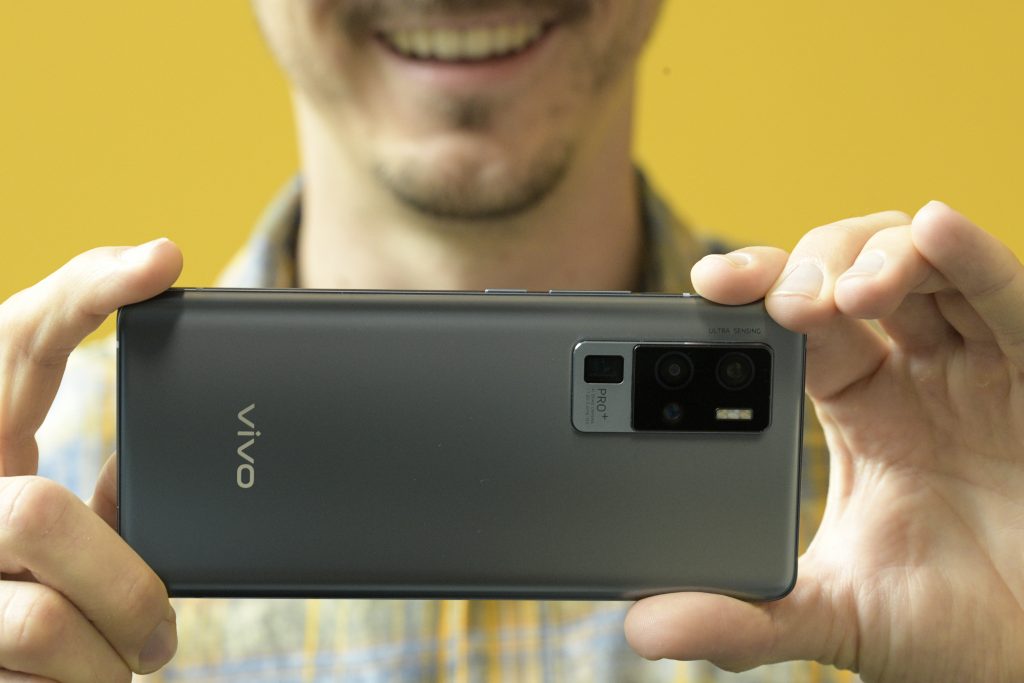
Key camera specifications:
- Primary: 50 MP 1/1.31-inch Quad-Bayer sensor, 24 mm-equivalent lens with f/1.9 aperture, dual-pixel PDAF and OIS
- Telephoto 1: 32 MP 1/2.8-inch sensor, 50 mm-equivalent (2x optical) lens with f/2.1 aperture, PDAF
- Telephoto 2: 13 MP 1/3.1-inch sensor, 124 mm-equivalent (5x optical) periscope lens with f/2.8 aperture, PDAF and OIS
- Ultra-wide: 13 MP 1/3.4-inch sensor, 16 mm-equivalent lens with f/2.2 aperture
- Dual-LED flash
- Video: 8K, 4K at 30 fps (tested)
- Qualcomm Snapdragon 865 chipset
About DXOMARK Camera tests: For scoring and analysis in our smartphone camera reviews, DXOMARK engineers capture and evaluate over 1600 test images and more than 2 hours of video both in controlled lab environments and in natural indoor and outdoor scenes, using the camera’s default settings. This article is designed to highlight the most important results of our testing. For more information about the DXOMARK Camera test protocol, click here. More details on how we score smartphone cameras are available here.
Test summary
The Vivo X50 Pro+ achieved a DXOMARK Camera score of 127 in our testing, an impressive performance that lands it in third place in our rankings behind the Huawei P40 Pro and the top-scoring Xiaomi Mi 10 Ultra.
Its Photo score is a very strong 139 (behind only the two front runners just mentioned), with the X50 Pro+ delivering very strong performance across the basics in our tests. Target exposure is generally accurate, as are white balance and color rendering. Dynamic range is wide, holding detail well in both shadows and highlights in high-contrast situations. It’s rare to encounter scenes that throw the X50 Pro+ for a loop.
Photographers who like to go long will appreciate the reach of the 124 mm-equivalent 5X zoom, and the phone also does well at mid-zoom settings, with detail nicely preserved throughout the zoom range. Wide performance is less impressive, with only moderate coverage from the 16 mm-equivalent lens and some quality issues that hold the score back.
Low light poses few problems for the X50 Pro+. It controls noise very well while keeping plenty of detail in images. Exposure remains accurate at night, with natural-looking white balance and pleasant colors. A few artifacts crop up, but not enough to spoil the party.
Portrait shots with simulated bokeh are good, but not on par with the phone’s best performance areas. Along with the little depth-sensing glitches that plague nearly all phones, the Vivo X50 Pro+ sometimes flubs subject separation more seriously. It renders out-of-focus highlights nicely, but the blur gradient is not as natural as it could be.
The Vivo X50 Pro+ also delivers excellent video performance, achieving a DXOMARK Video score of 104, again just behind the first and second place Xiaomi and Huawei (with 106 and 105, respectively). It was tested at its 4K 30 fps sweet spot (although it can also record 8K video). Exposure is generally accurate. The deft balance of detail and noise seen in stills output carries over to video, with video holding fine detail effectively while keeping noise in check. Autofocus is fast and tracks moving objects efficiently. Stabilization is nicely effective. There are some color cast issues, especially indoors; and color saturation outdoors, especially vegetation, could be better. Stabilization sometimes induces frame shift, but overall the video performance is praiseworthy.
Photo scores explained
The Vivo X50 Pro+ achieves an excellent Photo score of 139, behind only the Xiaomi Mi 10 Ultra and the Huawei P40 Pro to date. Performance is very good across most areas, with only a few stumbles holding it back, most notably its Wide test results. In this section, we take a closer look at how each sub-score was determined and compare image quality against key competitors in a similar price bracket.

Exposure and Contrast
Vivo X50 Pro+
98
111
The X50 Pro+ earns an exposure sub-score just one point short of the best we’ve recorded to date. Exposure is accurate, and the phone effectively captures very wide dynamic range scenes without losing detail in the shadows or highlights. Under most test conditions, it maintains proper exposure even at extremely low light levels, which is not a given even with other high-end phones.
In the scene below, the Vivo and Huawei nail the exposure, while the OnePlus goes a bit too dark.


In the higher-contrast scene below, the Vivo and Huawei phones do a good job of balancing the darker subject with the bright background without losing too much highlight detail, while the Samsung leaves the model a bit dark while blowing out the building and sky.


Color
Vivo X50 Pro+
91
107
The X50 Pro+ earns an excellent color score. Colors are pleasant and generally accurate. Automatic white balance is effective, biased very gently towards warmer rendition, which tends to be more flattering for people. It is also quite accurate across different light sources (some phones struggle with artificial light, for example) and at low light levels. The street scene below highlights the Vivo’s accurate and pleasant color rendition.


In the portrait below, the X50 Pro+ delivers nicely saturated colors along with natural skin tones for the model. The Huawei also handles the scene quite well, although the colors are slightly less saturated, while the Samsung runs amok with the model’s skin, giving it a strange bronze look.



Autofocus
Vivo X50 Pro+
100
109
The X50 Pro+ earns a perfect score in our autofocus tests, and its performance is in line with the best we see in top-end phones today. The phone locked focus quickly and accurately under all tested conditions. In bright outdoor light and in normal indoor lighting, acutance was pegged right at 100% in our trials, showing that the phone neither missed focus nor over-sharpened output to “exceed” perfect sharpness.
In the most challenging low-light test conditions shown in the graph below, acutance does climb above 100%, but that’s not unusual. Even in very dim light, focus is fast and consistent, with timings clustered tightly in the milliseconds before the photo was taken (achieved by using pre-shot images from the buffer, a common tactic that phones use to offset human reaction lag).
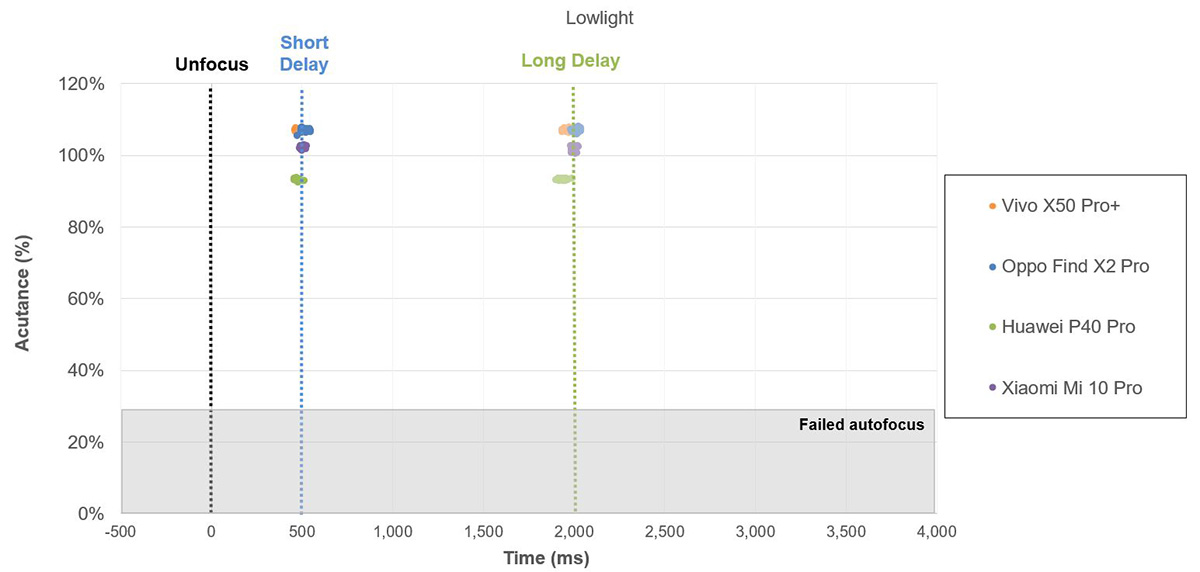

Texture
Vivo X50 Pro+
84
111

Noise
Vivo X50 Pro+
83
102
The Vivo X50 Pro+ does an excellent job of balancing noise and detail in still images. Its texture score is just one point shy of the highest we’ve measured, which is especially impressive considering that the highest score was achieved by the Xiaomi Mi 10 Pro, which has double the output resolution of the Vivo.
The X50 Pro+ resolves an impressive amount of detail in bright light. In the outdoor example below, we find very high levels of fine detail in the image, even in darker portions of the scene. The Huawei also does well here, and the class-leading Xiaomi reaps the benefit of its higher-resolution output combined with its texture-capturing prowess.
The X50 Pro+ holds on to detail at lower light levels, too. In the indoor sample below, all three phones produce nicely detailed output.
Despite the high level of detail the Vivo retains in its files, it also controls noise very well, earning the top score for still noise to date. In the crop from the X50 Pro+ sample below, note how little noise is visible in the dark tones, even though low-contrast detail that many phones would smear away is preserved.
Our lab results back up the perceptual assessment of the X50 Pro+’s low noise levels:
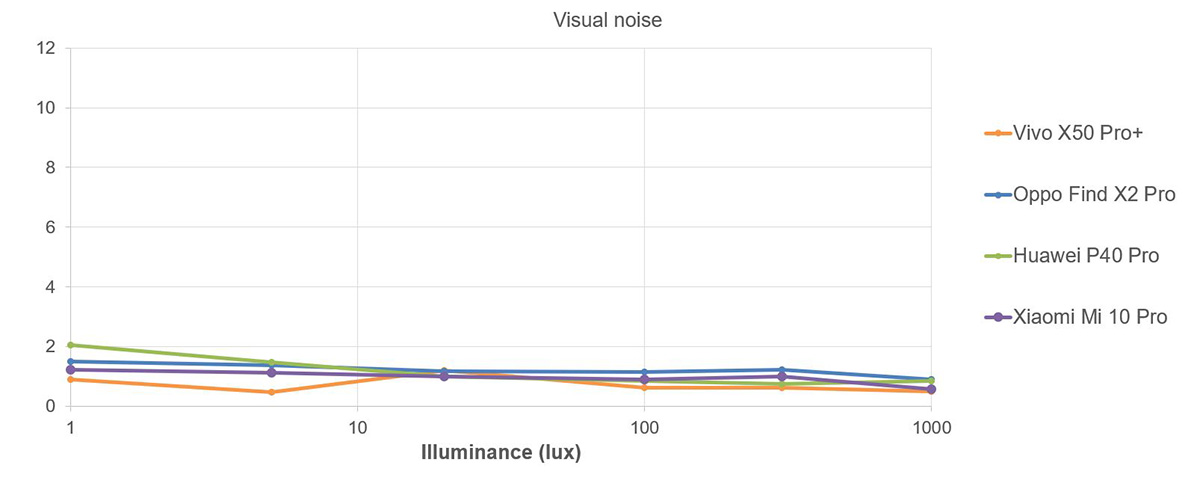
The X50 Pro+ generated several artifacts in its images, but most are rarely something you’re likely to notice if you don’t search for them. The most serious was ghosting in scenes with moving objects, a problem that emerges from a phone’s use of multiple stacked frames to boost image quality; as an example, there should be only two birds flying on the left in the photo below.
Our testers also noticed color spreading and aliasing along high-contrast borders, some softness in the corners, and some aliasing and moiré.

Zoom
Vivo X50 Pro+
109
The X50 Pro+ offers very good zoom functionality, although it doesn’t quite keep up with the very best performers in our database. The zoom system holds detail well throughout the range, helped by the reach of the 124 mm-equivalent lens in the long tele module. Fusion artifacts are sometimes a problem, but the phone usually handles them well, albeit at the expense of dynamic range, which can be somewhat limited.
At medium zoom factors (around 4x), the X50 Pro+ captures plenty of detail while keeping noise under control. In the sample below, the image is sharp corner to corner, though sometimes the phone does create fusion artifacts in this zoom range, as does the competition (strong blurring at the edges of the P40 Pro image, for example, is likely the result of output from the tele module with its narrower field of view switching over to heavily interpolated data from the next widest sensor).
At long zoom ranges, the X50 Pro+ continues to perform well. Detail and noise are nicely balanced, and we can see that the Vivo holds on to more detail than the Oppo. The Huawei might actually retain a bit more detail, but heavy processing produces a watercolor effect visible in the crop, while the Vivo sample remains natural-looking.

Bokeh
Vivo X50 Pro+
70
80
The X50 Pro+ can simulate shallow depth of field in its bokeh portrait mode with reasonable effectiveness, though it’s not as convincing when pulling this trick as the best devices. Flyaway hairs and other challenging details pose problems, but the X50 Pro+ appears to employ a relatively low-resolution depth map that sometimes produces more obvious errors when segmenting the subject and background. It renders distant backgrounds with a nicely intense blur effect and highlights are properly shaped, although the blur gradient is not always realistic on receding backgrounds.
In the example below, the X50 Pro+ has exposed properly and renders colors nicely. Strands of the model’s hair have been blurred, a common issue (though the best phones do better than this), but there is also a thin rim of sharp background distractingly visible along other parts of her hair. Stair-step artifacts along the smooth lines of her arms also mar the effect. The Oppo handles segmentation around the hair more convincingly (though the background is less blurred), and the Samsung, with its very capable bokeh simulation mode, does an excellent job all around.

Wide
Vivo X50 Pro+
36
58
The X50 Pro+ did well across most of our test suite, but the performance of its dedicated wide-angle camera leaves some room for improvement. With around a 16 mm-equivalent field of view, it does not deliver the coverage that the best competitors offer. There’s some softness towards the edge of the frame, which is not unusual, but the wide camera stumbles on some basics such as exposure (often too dark) and color rendition (sometimes unnatural).
While the phone balances detail and noise very well with its other cameras, the wide unit misses some detail while allowing more noise into the image than is ideal. It also struggles with high-contrast scenes, offering less dynamic range than we’d like to see. Artifacts are reasonably well controlled, but ghosting is sometimes visible.
Despite the fact that our lab testing reveals these shortcoming, the X50 Pro+ can certainly capture a nice-looking wide photo, as seen below. However, it’s apparent that the Samsung reaches wider while holding more fine detail in the image.

Night
Vivo X50 Pro+
70
82
The X50 Pro+ did well in our testing for nighttime performance, landing just two points shy of the current top-scoring device, the Xiaomi Mi 10 Ultra. Night and low-light exposures are accurate, and with pleasant colors and accurate white balance.
In flash-auto mode, the Vivo fires its flash appropriately for the scene below, lighting the subject well and rendering accurate color while allowing enough background to burn in to give the scene a natural feel. The Vivo captures more detail than the Huawei here, and despite its susceptibility to ghosting artifacts, it renders the model’s moving hand perfectly, while the Huawei shows a phantom limb.
The X50 Pro+ handles night cityscapes well, delivering bright exposures and accurate white balance despite the challenging mixed lighting. On the downside, sharpening artifacts sometimes give details an unnatural look. In the scene below, the Vivo scoops up more light than either the Oppo or the Huawei, producing a more generally pleasing photo, but we see the effects of unnatural sharpening on some details.
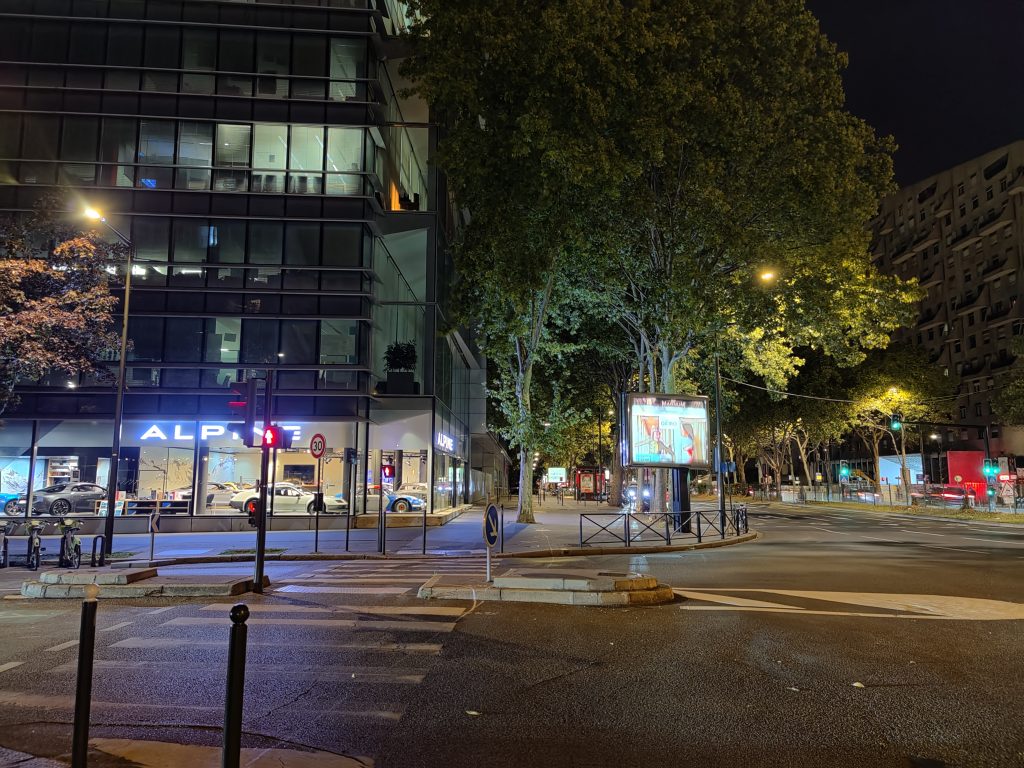
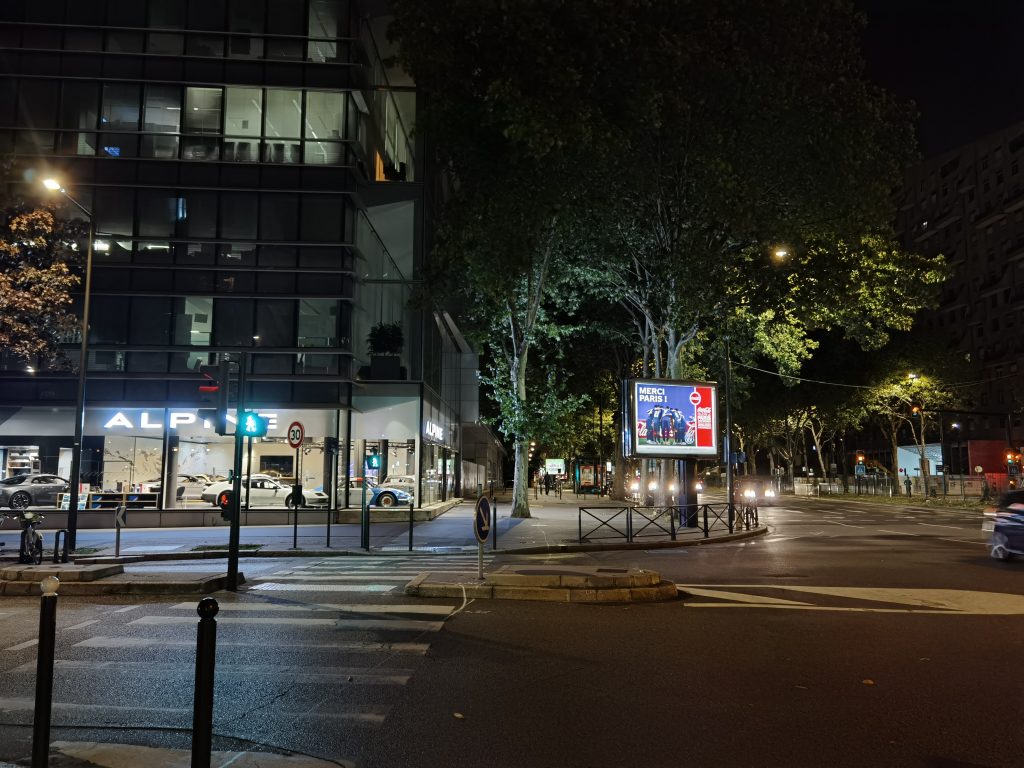
Flash-off mode produces good results, with accurate exposure, though chroma noise is sometimes visible and details are sometimes rendered unnaturally. The challenging sodium light in the scene below gives all the phones’ output an orange cast, but the Vivo does a pretty good job overall, capturing a nicely bright exposure (though at the cost of some red channel clipping that affects the model’s skin). In this case, the Huawei’s output looks more natural with good detail, while the Oppo’s rendering is too dark.
The X50 Pro+ offers a dedicated night mode, but it’s not clear that its results are better than those using normal settings. Exposure remains accurate, but skin tones can take on an unnatural look and artifacts such as ghosting and edge noise are sometimes visible.
Video scores explained
A device’s overall Video score is derived from its performance and results across a range of attributes in the same way as the Photo score. The Vivo X50 Pro+’s video scores are: Exposure (87), Color (90), Autofocus (98), Texture (83), Noise (81), Artifacts (84), and Stabilization (94). In this section, we take a closer look at the device’s strengths and weakness for video, with some comparisons against key competitors.
The X50 Pro+ delivered its best results in video mode when set to 4K resolution at a frame rate of 30 fps. It performs very well at these settings, achieving a Video score of 104, off from our highest score to date by two points. Target exposure is generally accurate, though our testers noticed some slight exposure instability.
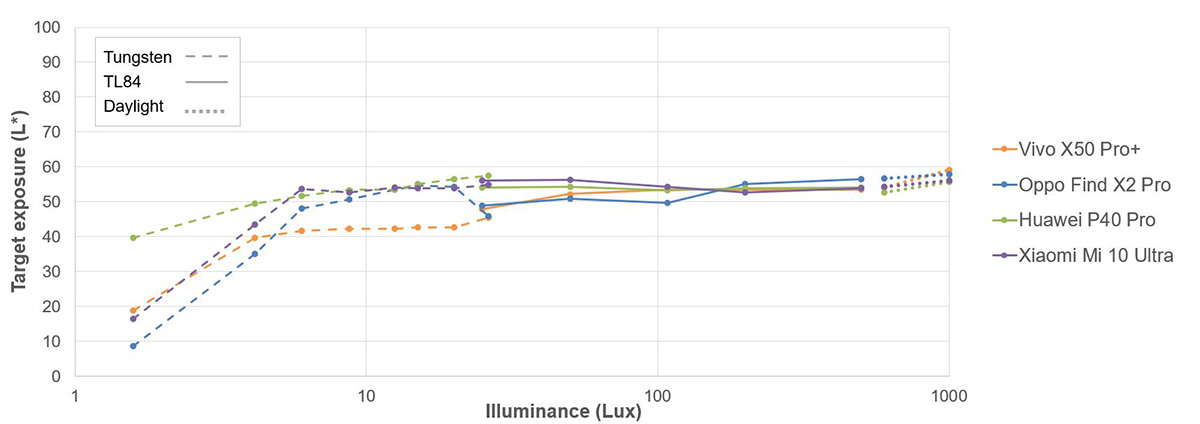
Color is not the X50 Pro+’s strong suit in video mode. Color casts are a problem, especially indoors, and colors sometimes appear washed out, especially the greens of leaves. Our lab chart below shows how color rendition can vary substantially with lighting type and intensity.
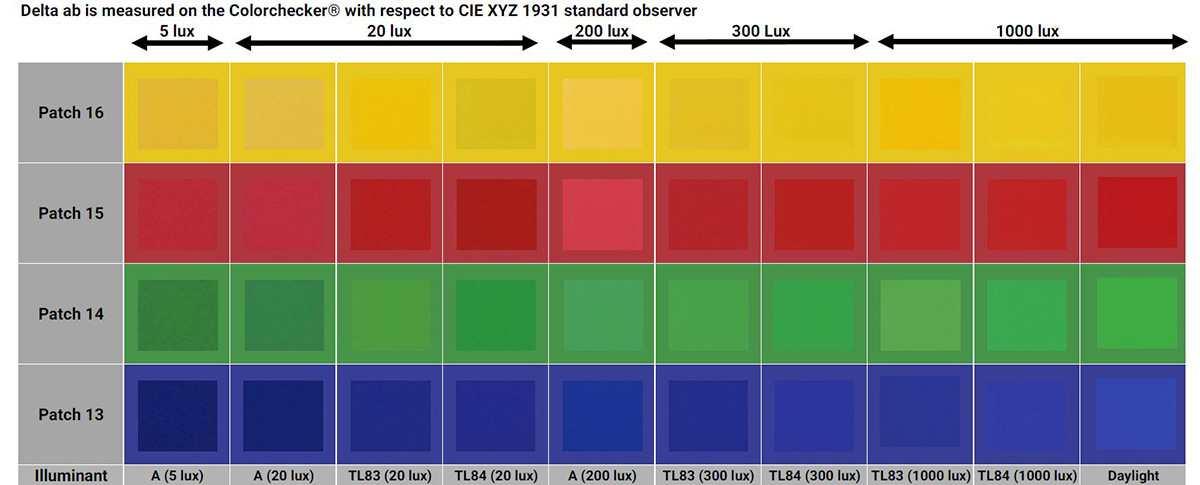
As with stills mode, the X50 Pro+ does a very good job balancing detail and noise when shooting video. In the chart below, only the top-scoring Xiaomi Mi 10 Ultra bests the Vivo in terms of detail, with the two front runners pulling away from the other devices as light levels drop.
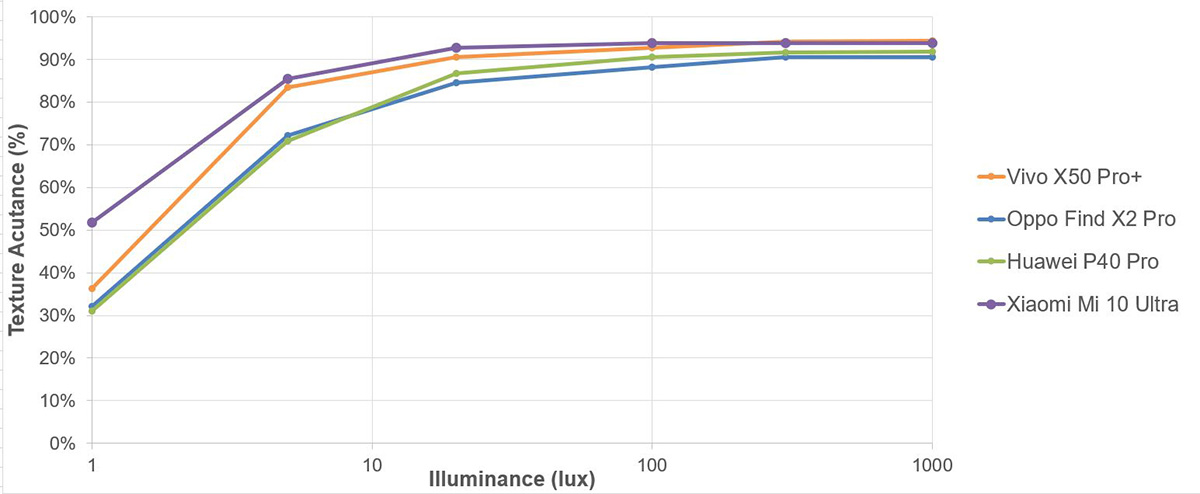
The Vivo’s edge for noise over the competition is less decisive, but it’s clear that its noise levels are low despite a strong detail performance.
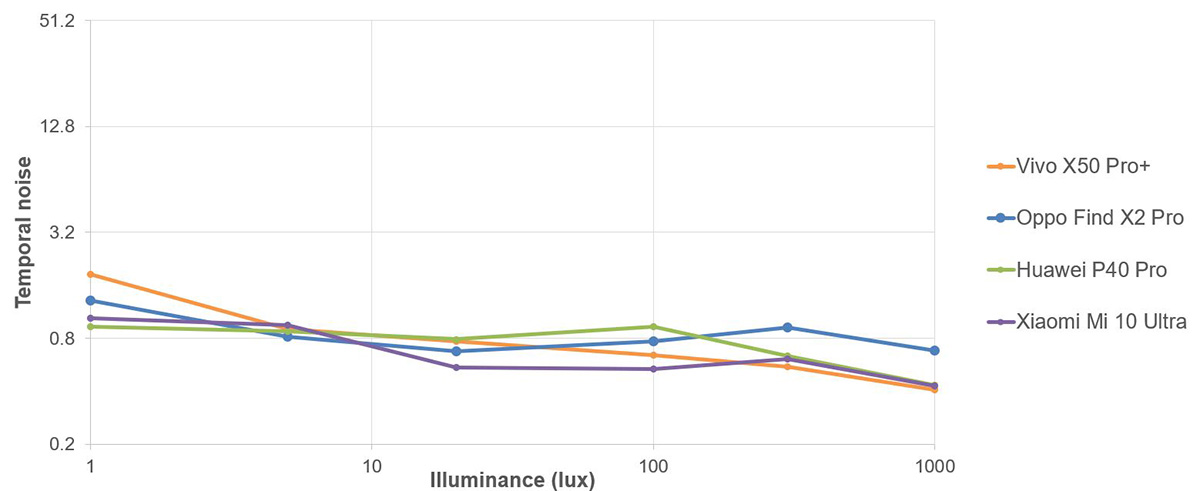
Autofocus in video mode performs well, with fast convergence and efficient tracking of moving subjects, though our testers noticed occasional focus instabilities. Stabilization is also reasonably effective, but it can introduce frame shift artifacts in which the frame appears to move when the phone is being held still.
Conclusion
The Vivo X50+ delivered a strong showing in our testing, landing in third place in our database. Its performance in Photo mode is generally excellent, with the phone delivering detailed, low-noise images with good color under most conditions. By flagship standards, a somewhat lackluster wide camera is the only real weak point, though the bokeh simulation mode could use some polishing to match the best of the competition.
Video performance is also strong, with detailed, low-noise 4K output, though stumbles in color rendition hold it back.
Photo
Pros
- High detail and low noise, even in low light
- Accurate white balance and pleasant colors
- Wide dynamic range
- High detail across the zoom range
- Generally accurate exposure with natural white balance and pleasant colors in night shots
Cons
- Strong ghosting in scenes with motion
- Color spread and aliasing artifacts visible along high-contrast boundaries
- Fusion artifacts in medium zoom range
- Underexposure and unnatural color in wide mode
Video
Pros
- Accurate exposure
- Well-controlled noise
- Fast autofocus and efficient tracking
- Effective stabilization
- High levels of detail
Cons
- Color casts, especially indoors
- Color quantization visible indoors
- Occasional autofocus instability
- Frame shift


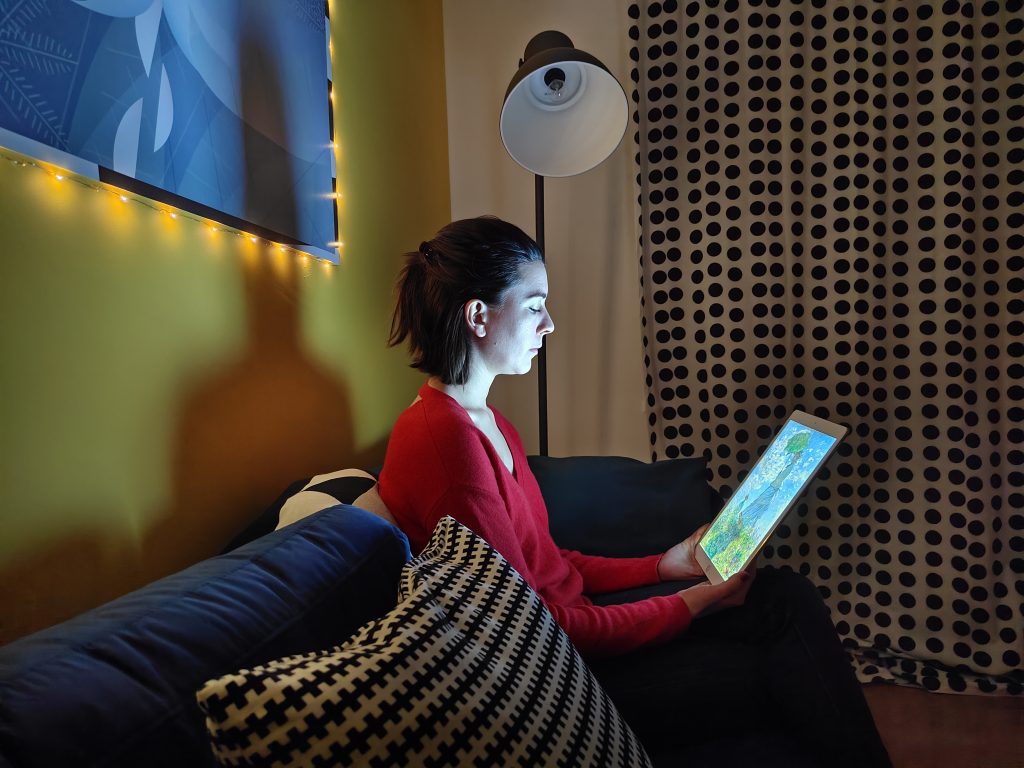


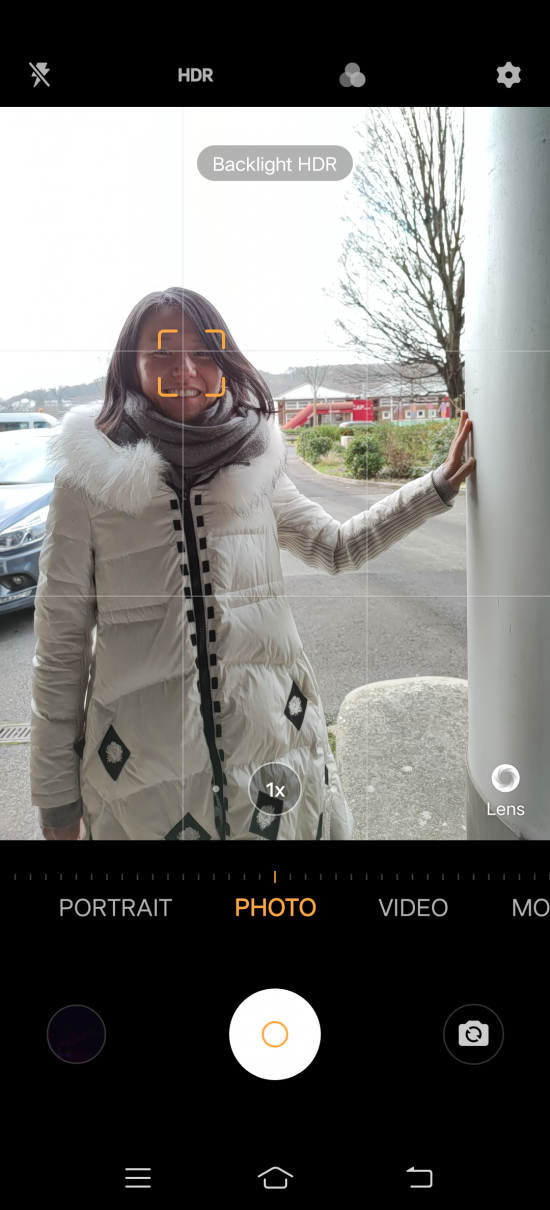






























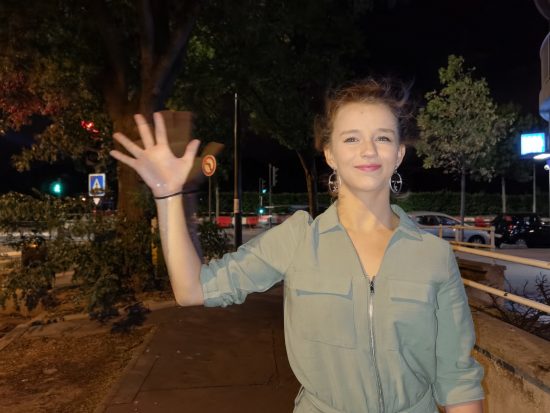
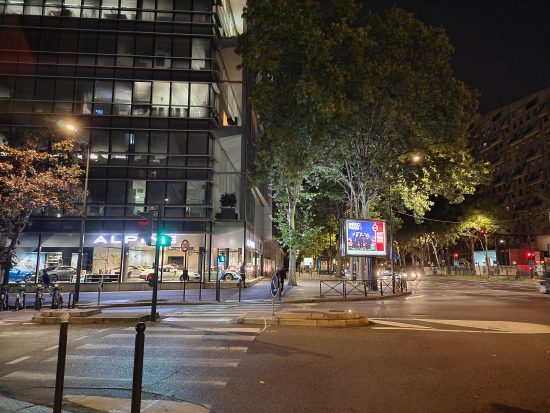
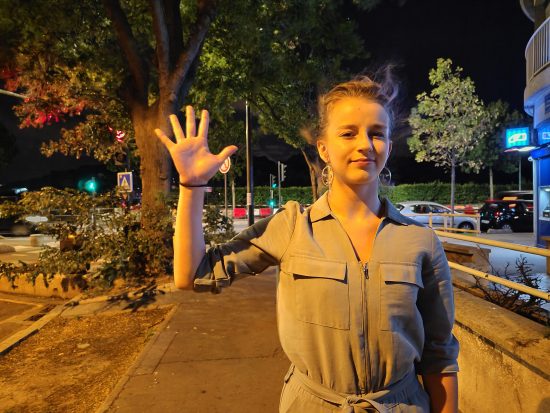

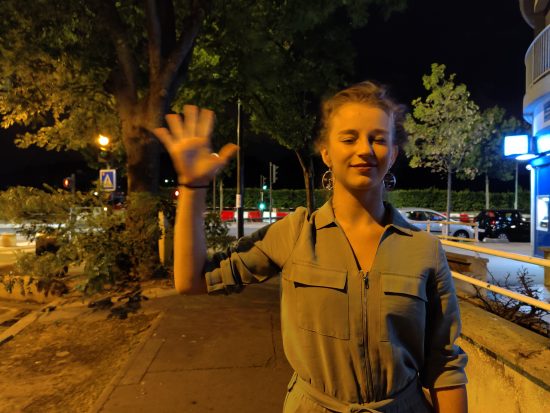


DXOMARK encourages its readers to share comments on the articles. To read or post comments, Disqus cookies are required. Change your Cookies Preferences and read more about our Comment Policy.